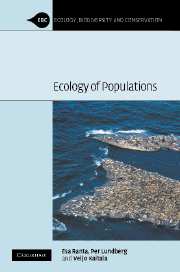Book contents
- Frontmatter
- Contents
- Preface
- 1 Introduction
- 2 Population renewal
- 3 Population dynamics in space – the first step
- 4 Synchronicity
- 5 Order–disorder in space and time
- 6 Structured populations
- 7 Biodiversity and community structure
- 8 Habitat loss
- 9 Population harvesting and management
- 10 Resource matching
- 11 Spatial games
- 12 Evolutionary population dynamics
- 13 Epilogue
- References
- Index
6 - Structured populations
Published online by Cambridge University Press: 02 December 2009
- Frontmatter
- Contents
- Preface
- 1 Introduction
- 2 Population renewal
- 3 Population dynamics in space – the first step
- 4 Synchronicity
- 5 Order–disorder in space and time
- 6 Structured populations
- 7 Biodiversity and community structure
- 8 Habitat loss
- 9 Population harvesting and management
- 10 Resource matching
- 11 Spatial games
- 12 Evolutionary population dynamics
- 13 Epilogue
- References
- Index
Summary
Populations are not collections of identical individuals, albeit such approximations are often useful. In many cases, however, a higher resolution is needed to understand population and community processes. In this chapter, we introduce some more details by letting the population be divided into age or stage classes, all of them possibly with their specific vital rates. This can be achieved by rather small modifications of the simple models, yet qualitatively and quantitatively new phenomena will emerge.
The state of a population is usually thought of as its size or density. As we have seen, it is in fact the density-dependent feedback that is assumed to be important at the population level. The implicit assumption behind this is that all individuals are more or less identical when it comes to their demographic effects: their contributions to births and deaths (and immigration and emigration). This is, of course, not the case in most natural populations. Young individuals are often more susceptible to death than adults, and they often contribute less to reproduction. Individuals at some intermediate adult stage face less risk of dying and are the ones that reproduce successfully. Such differences are not necessarily only attributed to age, but also body size (often co-varying with age). For example, in most species with indeterminate growth, as in fish and reptiles, fecundity and survival are strongly dependent on size, rather than on age per se (Roff 1992; Stearns 1992).
- Type
- Chapter
- Information
- Ecology of Populations , pp. 131 - 151Publisher: Cambridge University PressPrint publication year: 2005



